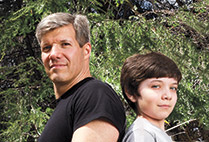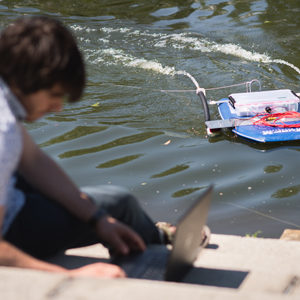In The Jetsons, the helper robot of the future handles all manner of chores. Rosie can do the laundry, pick up the groceries, and keep Elroy out of trouble.
In today’s reality, we have all kinds of artificial intelligence (AI) at work for us—they scour the web for information, diagnose car trouble, even perform surgeries. But no one of these specialized machines could perform all of those tasks, or even much of a variety of tasks. In fact, just one of our everyday errands would pose a challenge for a traditional robot. Rosie would be stymied by a stray shopping cart in her path, and she wouldn’t know what to do if Jane’s favorite brand of margarine were out of stock.
But Massimiliano “Max” Versace, a College of Arts & Sciences research assistant professor and director of BU’s Neuromorphics Laboratory, hopes to change that. His team is building the brain of a versatile, general-purpose robot—maybe not a humanoid, wisecracking helper, but, let’s say, a really smart dog. And with a grant from NASA, that pup may soon be prowling other planets. The Neuromorphics Lab is part of BU’s CompNet (Center for Computational Neuroscience & Neural Technology) and the National Science Foundation–sponsored CELEST (Center of Excellence for Learning in Education, Science and Technology).

Massimiliano Versace and a team of BU engineers have designed a robot that NASA will use to collect information from the surface of Mars. Photos by Cydney Scott
Versace (GRS’07) is working on the cutting edge of a convergence of neuroscience, computer processing, and other disciplines that promises to yield a better robot, one with a “brain” modeled after that of a mammal.
As Versace and colleague Ben Chandler (GRS’14) write in an article in IEEE Spectrum, an ordinary rat, whose brain runs on the energy equivalent of a Christmas-tree bulb, can explore unfamiliar tunnels, avoid mousetraps, follow a food aroma coming from an unexpected source—all things that might befuddle a robot.
It’s that ability to learn and adapt that Versace hopes to replicate in an artificial brain. To do it, he’s made use of a breakthrough electrical component designed by Hewlett-Packard, called a memristor. He and his team have assembled networks of these microscopic devices to mimic the brain’s neurons and synapses, saving a massive amount of energy while allowing the storage and processing of information to occur simultaneously, as they do in mammalian heads.

Last spring, after repeated tweaks, the lab’s virtual rover learned the spatial layout of a highly realistic virtual Martian surface and identified science targets.
In the lab’s first series of experiments, in 2011, the BU team built a rodent-size brain and let it loose in a virtual tub of water. With training, rather than explicit programming, the “animat” eventually figured out on its own how to find dry ground.
Once Versace and his colleagues demonstrated that success, NASA came calling, tapping the Neuromorphics Lab for two high-altitude projects. In the first, the researchers have been charged with designing a Mars explorer that will operate autonomously, navigating and collecting information using passive rather than active sensors.
“An active sensor is, for instance, a laser range finder, which shoots laser beams to estimate the distance from the robot to a wall or object, or even to estimate object size,” Versace explains. “Biology does this task with a passive sensor, the eye, which absorbs energy, light, from the environment rather than emitting it. An active sensor means spending more money and having more weight to carry—sensor plus battery. This is just one example in a trend that sees traditional robots burning tons of energy to do tasks that in biology take a few calories.”
Last spring, after repeated tweaks, the lab’s virtual rover, outfitted with biological-eye-like passive sensors, successfully learned the spatial layout of, and identified science targets within, a highly realistic virtual Martian surface. Versace and his colleagues are testing the system in a real-life metal-and-plastic robot in a physical “Mars yard” they built in the Neuromorphics Lab.
The lab’s second NASA project also marshals mammal-style sight, but for a use closer to home. By fall 2015, the Federal Aviation Administration will fully open US airspace to unmanned aerial vehicles—with the common-sense provision that the machines must be at least as adept as human pilots at sensing and avoiding oncoming objects.
The biological advantage Versace and his colleagues have identified in humans is our sense of optic flow. We don’t typically think about it as we’re walking down the street, but the way we perceive our own forward motion is that stationary objects in the distance appear to gradually grow larger while the stationary objects we’re passing appear to more quickly move past us.
When one object is moving in our field of vision at a rate faster than the rest, we quickly zero in on it, understanding it to be one we may need to alter our course to avoid.
For a computer, this is not always so obvious, largely because a conventional computer has no fear. That may seem like an asset in a Daredevil comic book, but for an entity piloting an airplane, it is a decided liability. As it turns out, our biological anxiety is often an indispensable mode of self-preservation.
That’s why Versace and company are testing various algorithms that have the AI pilot experience something like pain. During repeated virtual flight tests, the AI is punished for colliding with an oncoming plane and rewarded for avoiding it. “Our task is to build a brain that senses when these obstacles start expanding,” says Neuromorphics Lab postdoctoral associate Timothy Barnes, “and decides early on, is it dangerous or not? And if so, to make a maneuver to avoid it.”
“This will give us insight into how the brain works,” says Versace. “Learn by creating is probably the best advice I can give to anybody who goes into a scientific field. If you are able to re-create what you think you know, you will have a much more powerful understanding of what you are trying to study.”


















































The technology is moving very fast, I hope it will always be used for good purposes in our next generation of technology.